Thatch - 2012
'09 maps for:
Bea
--
Buck -- Caley --
Claws --
Conomo --
Hix --
Hudson 09 -- Isabel --
Katy -- L.R. --
Moffet --
Mr. Hannah --
Ozzie --
Penelope
--
Rafael
2010 maps for: Belle
-- Buck --
Gunny --
Hudson --
Mr. Hannah --
Neale --
North Fork Bob
--
Penelope --
Sanford
-- Sr. Bones --
Thatch
2011 maps:
Belle --
Buck --
Henrietta --
Katbird
-- North Fork Bob --
Pemi --
Saco --
Sanford --
Sr. Bones --
Snowy --
Thatch -- Tucker
2012 maps: Art -- Belle -- Bridger --
Chip -- Cutch --
Jill -- North Fork Bob --
Rammie -- Snowy --
Sr. Bones -- Thatch
2013 maps: Art --
Belle --
Bridger --
North Fork Bob --
Rammie --
Snowy --
Sr. Bones
Osprey
main page --
Migration
page --
Migration09 --
Migration10 --
Migration 11 --
Migration 12 --
Migration 13 -- Home
Page
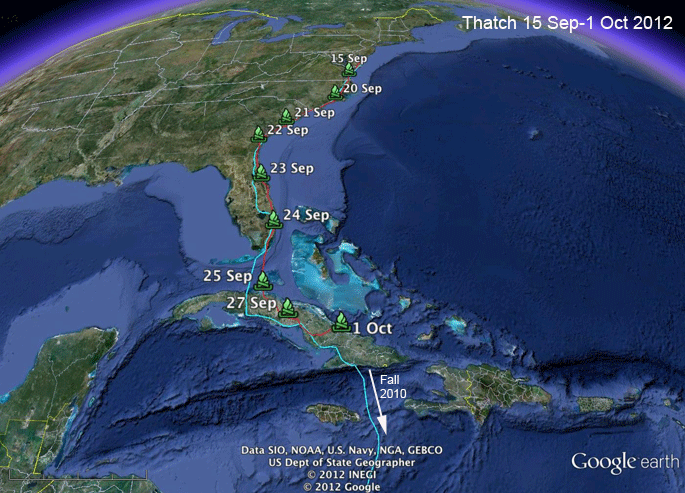 |
15 Sep-14 Oct 2012. Thatch finally started migrating, leaving Cape May at about 9:30AM on the 15th--teenagers never get started early! As of the 1st of October he was on the northern coast of Cuba in a spot that looks like Osprey heaven. He moved on through Cuba and Hispaniola and then crossed the Caribbean in style and without incident. Sadly, he stopped on Curacao for a couple of weeks and either dropped his transmitter (unlikely) or died--perhaps the victim of a shooting. Scroll down for all of Thatch's maps for 2012, or... Skip to the start of fall migration. |
 |
3 Sept 2012. For most of August, Thatch has been hanging out at Cape May, NJ. Knowing how many birders there are over there, I put out a "hit" on Thatch through the Delaware Valley Ornithological Club, asking for someone to shoot Thatch--with a camera, of course! It didn't take long. Georgia and Barrie Ashby took this shot at 9:23AM on Sept. 3rd as Thatch flew over one of the ponds around the lighthouse. I wonder how many times Thatch will get counted by the hawk migration watchers before he heads south. ;-) |
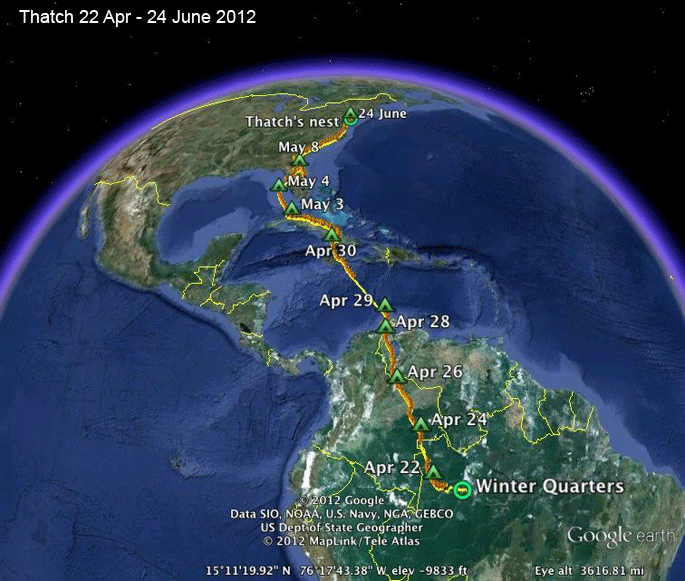 |
Spring Migration overview: 4 June 2012. Home at last! Thatch must have finally caught the last fish in the Turtle River and decided it was time to get to his high school reunion after all. He spent a little over a month fishing just west of Brunswick, GA, and then all of a sudden took off and was home 6 days later! You know the drill--scroll down for the rest of the story. Start of spring migration Florida and points north Summer movement Fall migration |
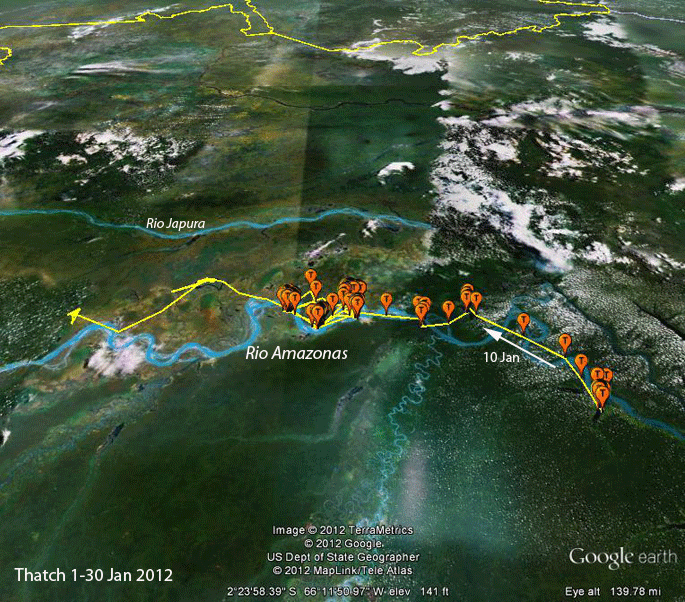 |
1-31 Jan 2012. Thatch's New Years' resolution: I think I should explore more and not be satisfied with just the same old same old.... So it's back upriver for our intrepid teenager. |
 |
1-29 Feb 2012. Thatch is exploring new territory here. He's never been this far west. It's very unusual for a bird that's been down on the wintering grounds to explore new countryside more than a year after arriving. |
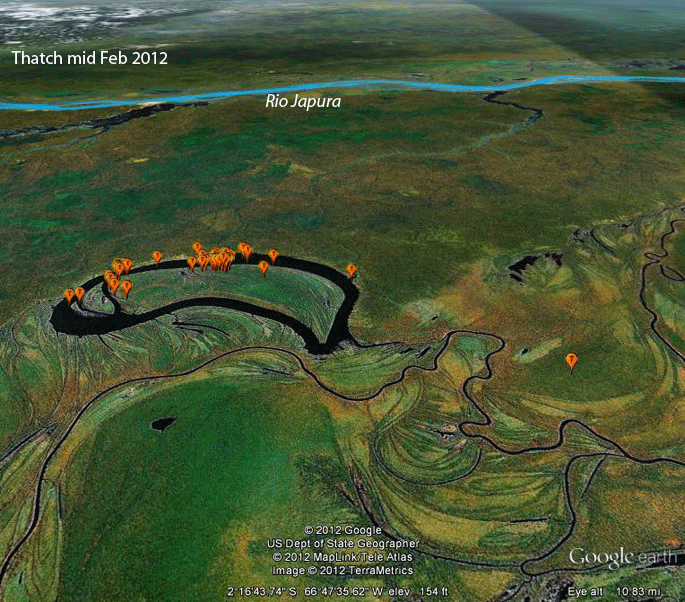 |
Mid February 2012. I just love looking at the intricate and almost abstract patterns that the big rivers etch through the landscape of Amazonia. The lake where Thatch spent a few days in February was once, thousands of years ago, a loop of the Amazon, which is now 15 miles southwest of this lake. |
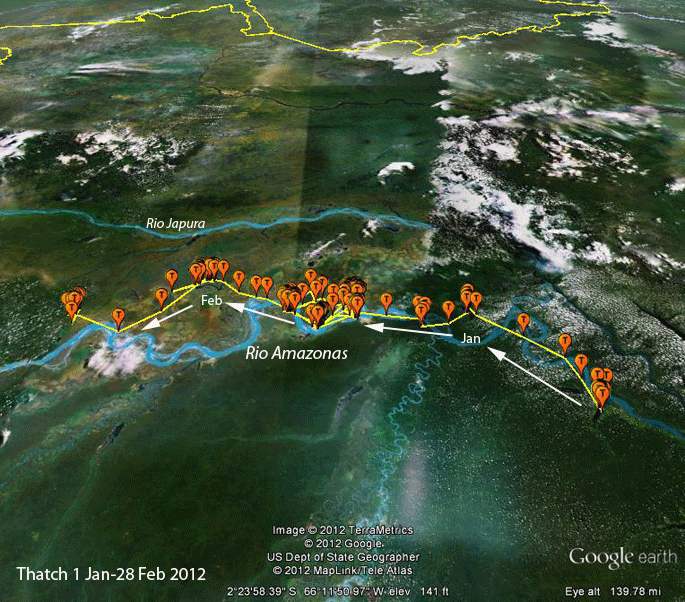 |
1 Jan - 29 Feb 2012. Here's his track for January and February. |
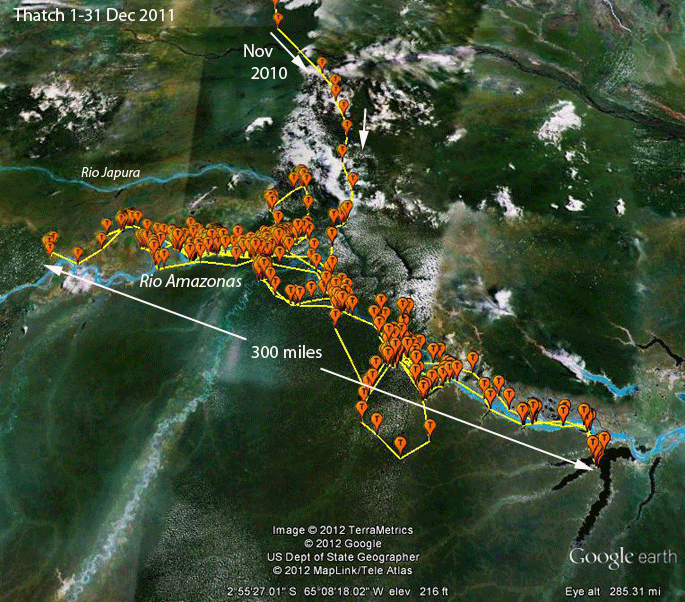 |
Nov 2010 - Feb 2012. This map shows all of Thatch's travels for the 15 months he has spent along the Amazon River. He should be heading north in April or May. |
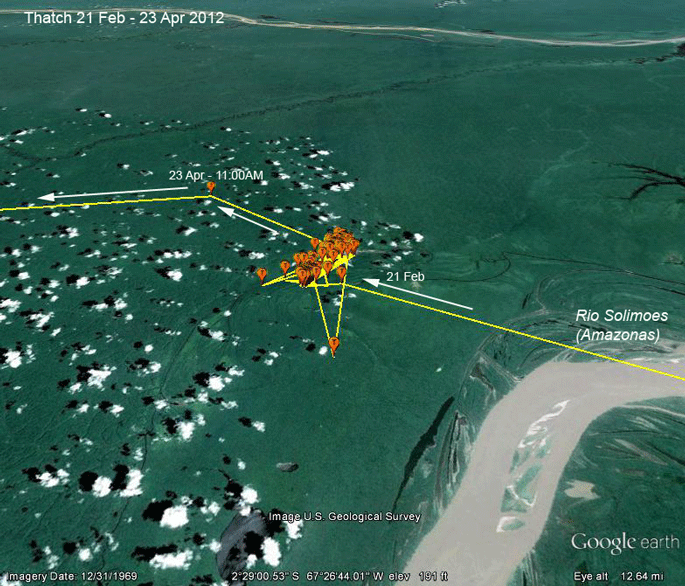 |
1 Mar - 23 Apr 2012. This map shows the small cluster of locations in the far west of his 15-month range (shown in the previous map). He spent his last two pre-migration months fueling up in this small area before taking off for "points north" (an old friend of mine used to think that was a town somewhere north of Boston) around 10:00AM on the 23rd. |
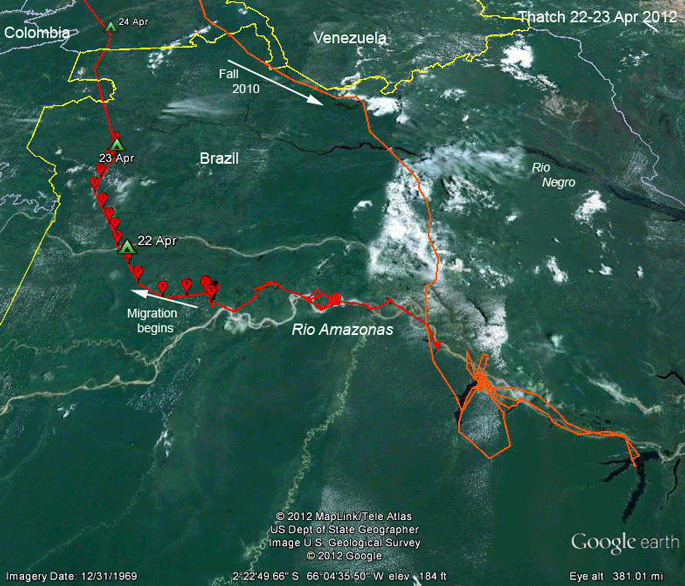 |
22-23 Apr 2012. Thatch is heading home! |
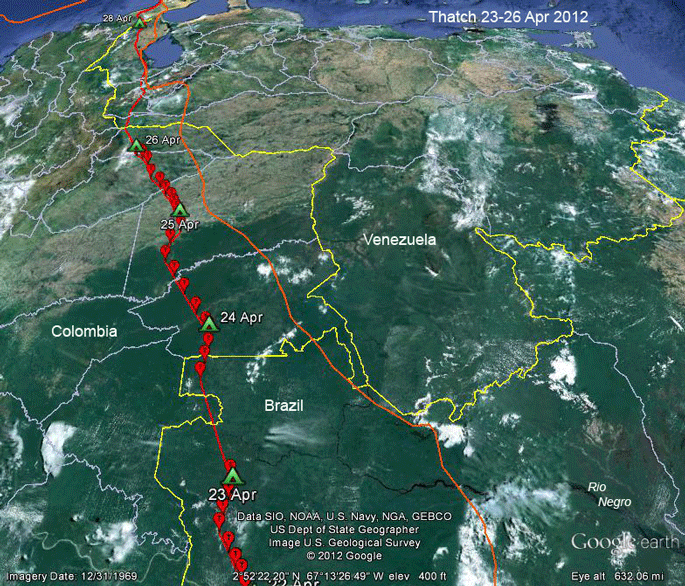 |
23-26 Apr 2012. Thatch is following a course pretty much parallel to the route he took coming south back in the fall of 2010 (in orange). |
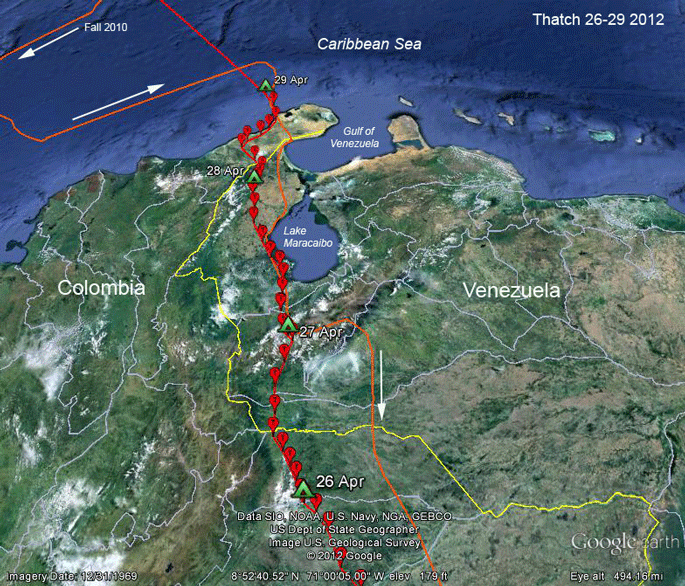 |
27-29 Apr 2012. As he climbed over the Cordilleira de Merida and headed down into the Lake Maracaibo Basin, he was covering some familiar ground--his route south back in 2010. On the 28th he roosted in Venezuela, close to the Colombian border, just south of the Guajira Peninsula. |
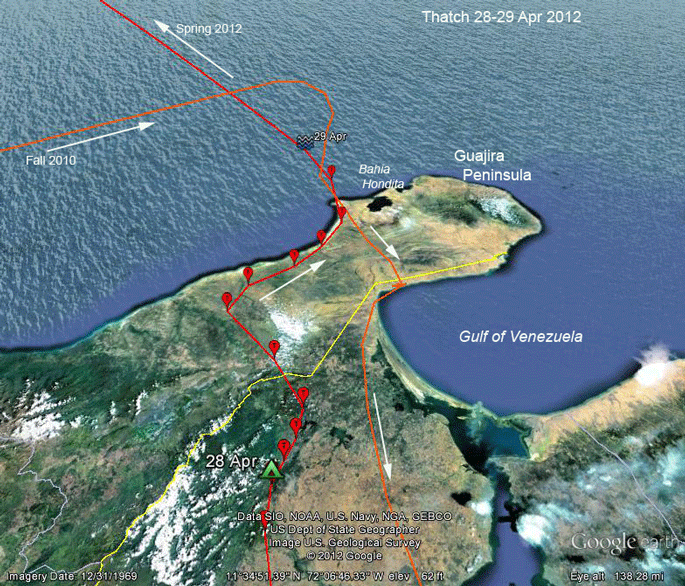 |
29 Apr 2012. Thatch took off shortly after 7AM on the 29th, heading northwest. When he got close to the coast he realized he could stay over land (one of the prime directives in Osprey migration) and still make progress north (I'm not implying this was a conscious decision, but rather an instinctual one) if he headed northeast. So he did. At about 4:30PM he was at the coast just west of Bahia Hondita, where our first juvenile (Jaws) to make it to South America spent his 18 months "down south." Normally, I'd expect a bird to stop at the coast this late in the day. But our boy was on a roll and pushed out over the Caribbean.... |
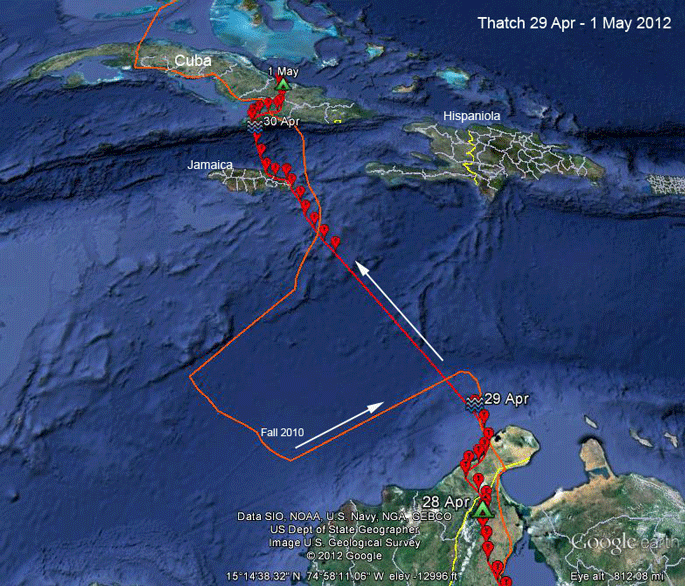 |
29 Apr - 1 May 2012. The last GPS fix for the day was at 6PM. He flew through the night, maintaining a very tight compass heading until he reached Jamaica around 11AM, 28 hours after he started this leg of his journey. It doesn't look like he stopped to rest until he had flown another hour. During that period he flew 630 miles (1,010 km) at an average pace of 22 mph (35 kph). (He had a pretty rough crossing on the way south!) |
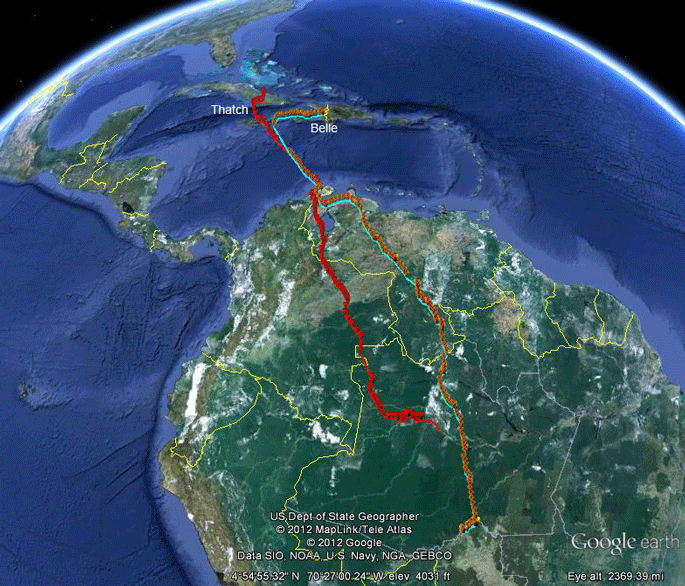 |
This map and the next show us how migratory routes are shaped by geography. While less averse to migrate over large expanses of open water than those raptors that really depend on thermals, Ospreys stay over land as long as possible, as long as they are heading in the appropriate general direction (north in spring, south in fall). This is true of most birds, and it's why south-pointing peninsulae (is that just too tacky?) like Cape May are such great spots to watch migration in the fall. Similarly, the Guajira Peninsula in Colombia would be a phenomenal place to watch Ospreys (and who knows what else) migrate north in the spring. |
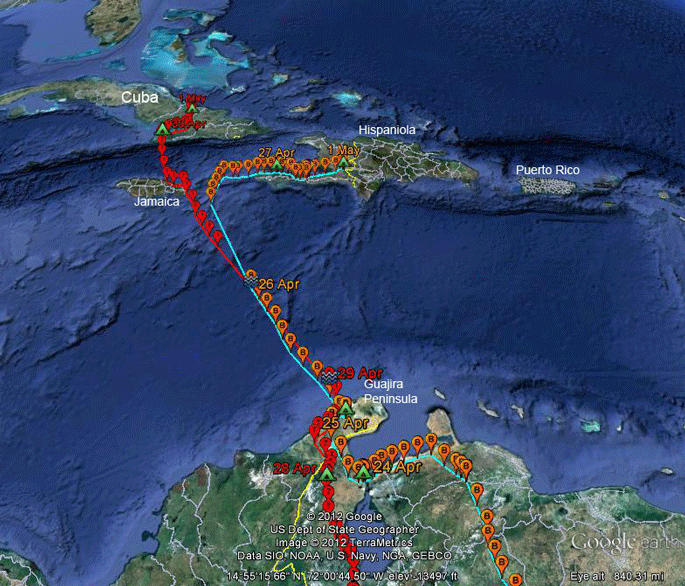 |
Here's a closer look at
how Belle (blue track, orange balloons) and
Thatch (red and red) were funneled to this
northernmost spit of South America. We cam only speculate about why they split tacks at some point southeast of Jamaica, but it probably is related to wind direction. We can infer from all the Ospreys we've followed that they really don't care about details in the middle of their migration--they "go with the flow" and let the wind push them a bit east or west--as long as they're staying over land and heading in the right general direction. When they get close to their destination, then true navigation kicks in and they head for their nest or wintering area, whichever way the winds are blowing. |
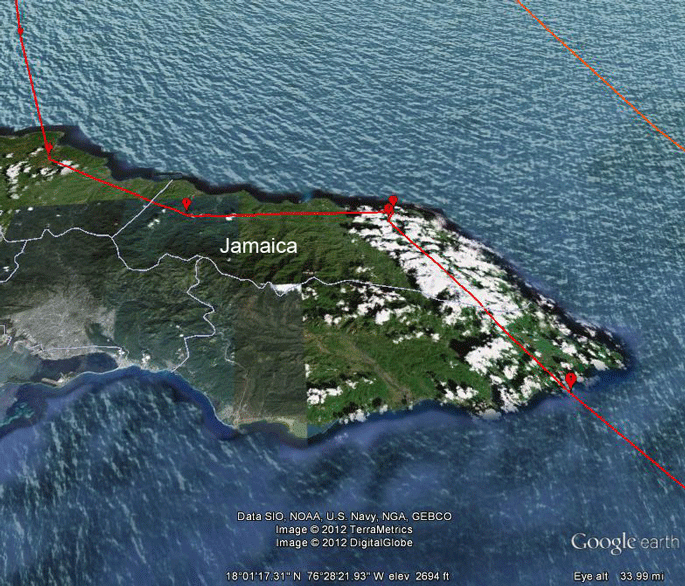 |
30 Apr 2012. When Thatch finally stopped for a breather near Jamaica's north shore, after 29 hours on the wing, it was only for an hour before kicking off and continuing his migration. This is a bird on a mission! And it certainly tells me that the transmitters are not a burden. |
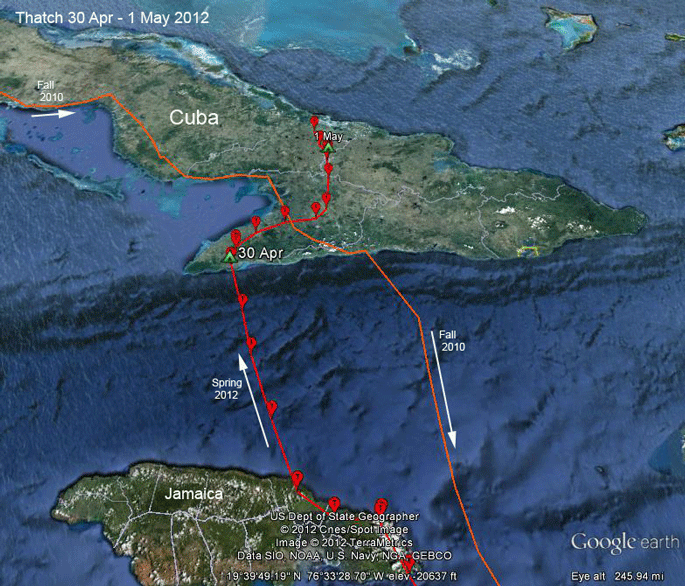 |
30 Apr - 1 May 2012. After his one-hour pit stop, he flew another 6 hours, crossing 113 miles (182 km) of open water between Jamaica and Cuba. When he settled down for the night on 1 May, his roost-to-roost distance traveled was 1,800 miles (2,920 km) in just 9 days. |
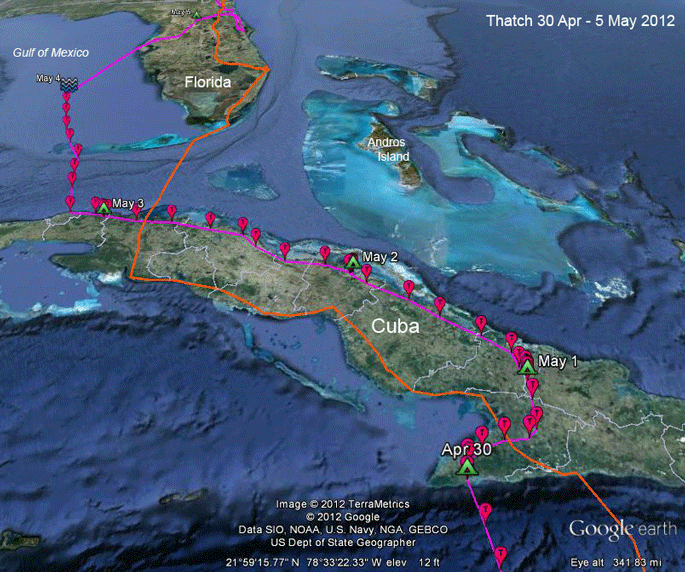 |
1-4 May 2012. This is how we like to see out birds move through Cuba--quickly! We don't want them stopping to spend any time at fish farms. The orange track is his route south back in the fall of 2010. He crossed that path twice in his travels through Cuba. Apparently, he didn't remember to turn north when he was just south of Florida, so he made an easy trip a bit longer than it had to be. He left Cuba around 11 AM on May 4th. At 7 PM we got his last GPS fix. He kept on flying and hit the Florida coast 120 miles later, probably around midnight, just west of Tampa. |
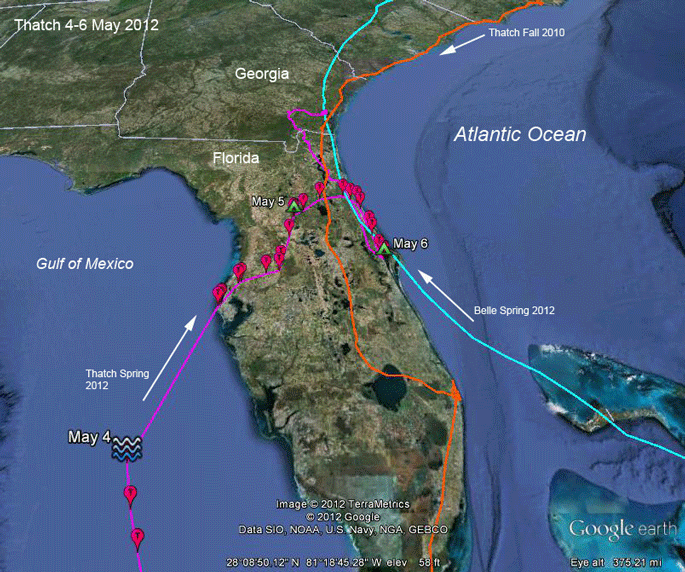 |
5-6 May 2012. Thatch worked his way across Florida on the 6th. For some reason, when he got to the east coast he turned south. He spent the night down by Cape Canaveral, which proved to be a popular spot this spring. Thatch's cohort-mate Belle flew through Cape Canaveral on her way north about a week after Thatch was there. |
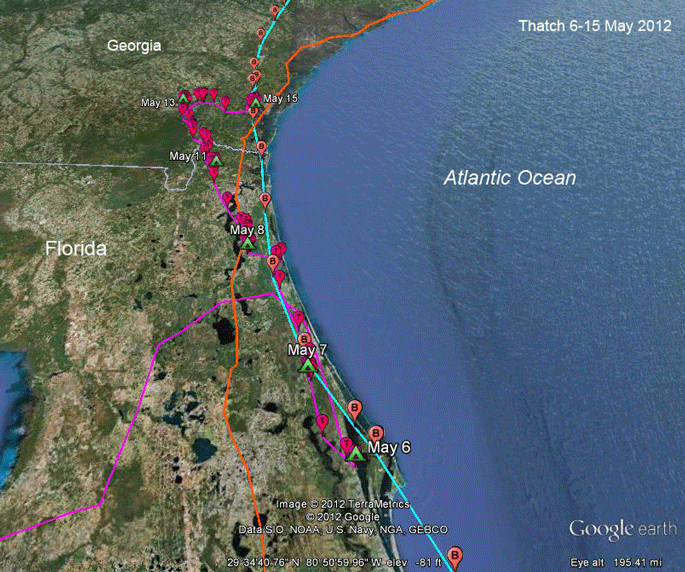 |
6-15 May 2012. After a night at Cape Canaveral, Thatch headed north--maybe he spent some time at the space center getting his internal compass realigned. On the 15th he made it to the coastal marshes just west of Brunswick, GA. |
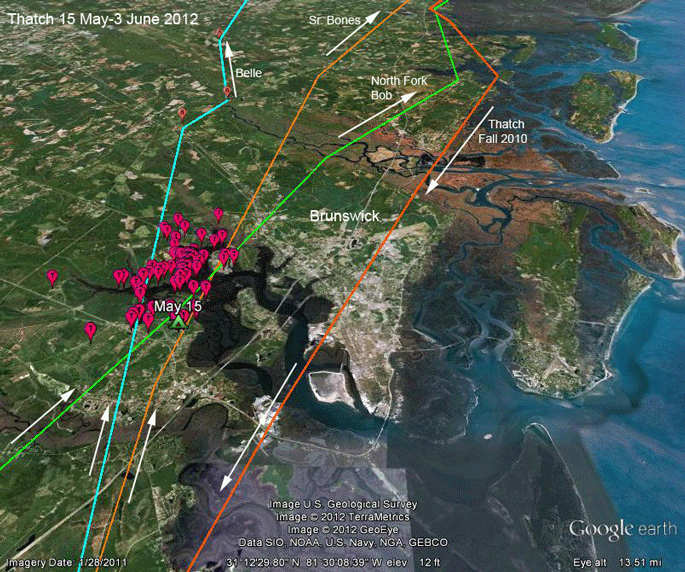 |
15 May - 3 June 2012. This looks like Osprey Heaven. He's spent two weeks here, so far. Every young that we watch come home for the first time provides fascinating insights into the process of a bird getting established in the breeding population. Will he stop here? Almost all males nest very close to their nest (within 10-20 miles), so we expect Thatch will continue north at some point, and he may not even make it all the way home. One young tagged in Minnesota never did get all the way home. It spent the summer in Louisiana and returned south in the fall without getting close to his home turf. |
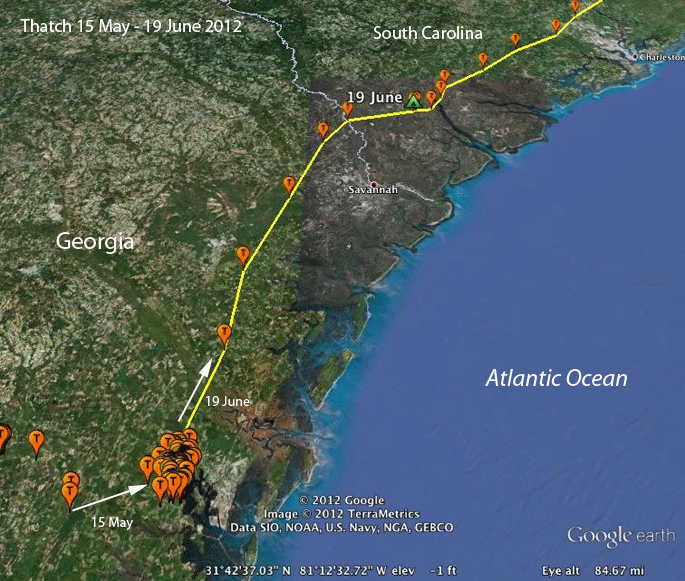 |
15 May - 19 June 2012. Thatch is finally on the move. I was wondering if he was going to spend the whole summer in Georgia. This would not be unprecedented. A young tagged by my colleague Mark Martell in Minnesota got to Louisiana on his first trip north and spent the whole summer there. Thatch started the last leg of his migration around noon on the 19th. About 6 hours later he settled down to roost for the night just west of the Broad River. |
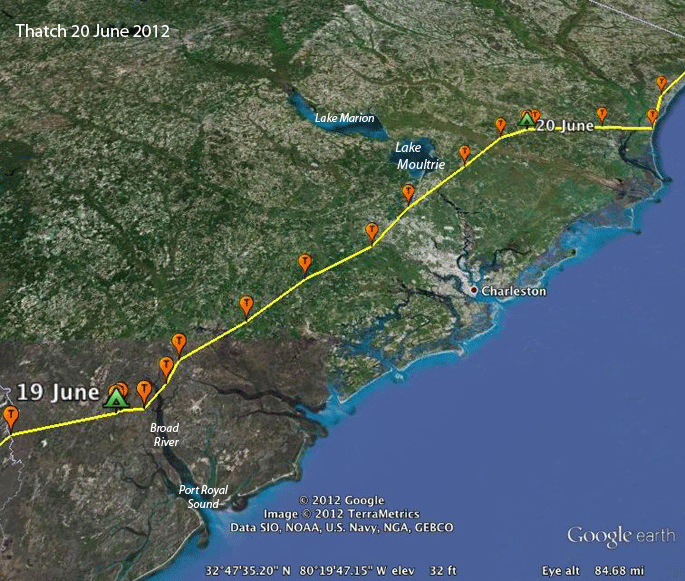 |
19-20 June 2012. Thatch got started sometime after 7 AM and moseyed along, probably doing some hunting until 10 AM. In those 2-3 hours he moved only 13 miles (21 km). That's much too slow for a bird actually in full migration mode, so I suspect he was hunting. But the interesting thing is that he was heading in the right direction as he wandered around the area--clearly multi-tasking! Around 10, he got going. About 7 hours later he settled down for the night. |
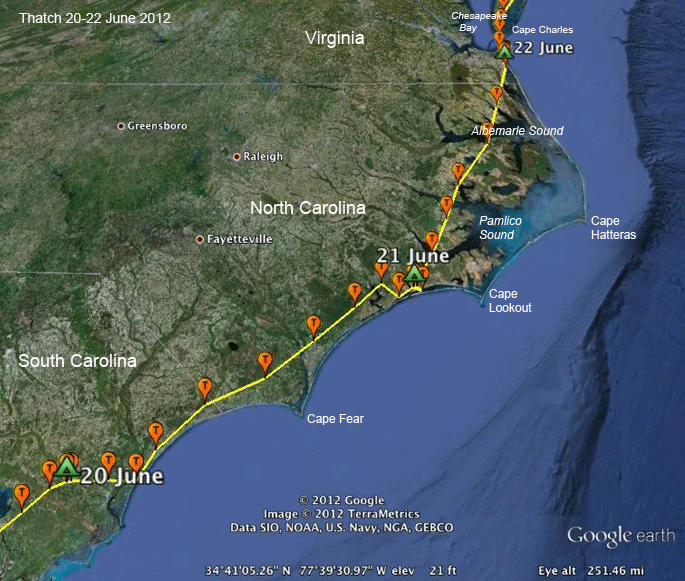 |
20-21 June 2012. Thatch is in full migration mode, moving up the coast. He crossed the VA state line around 2:30 PM and settled down west of Norfolk for the night sometime before 4 PM. |
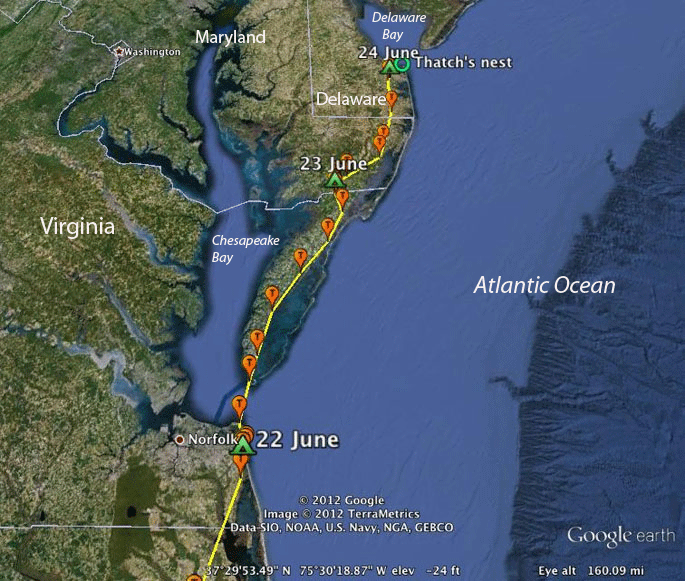 |
23-24 June 2012. Thatch crossed the mouth of Chesapeake Bay between 8 and 9 AM on the 23rd and then moved 89 mi. (143 km) north through the DelMarVa (Delaware, Maryland, and Virginia all claim part of this bit of land) peninsula in about 5.5 hours. He started the last leg of his trip sometime before 8 AM on the 24th, but was only drifting in the general direction of home, a mere 56 linear miles (90 km) from his evening roost. He did some serious dilly-dallying along the way, given that it took him over 5 hours to move about 60 miles. By 1 PM he was back in his old back yard, 660 days after he first left home back on the 4th of September 2010! What a guy. |
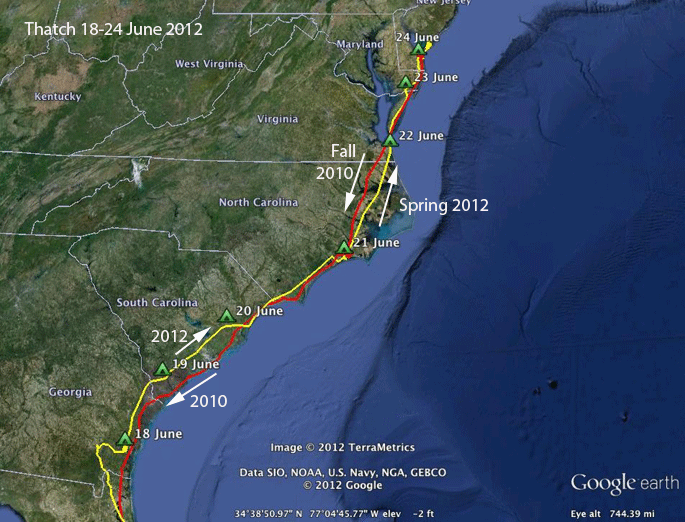 |
18-24 June 2012. Thatch covered fairly familiar ground on his trip north, never far from the track he laid down back in the fall of 2010. |
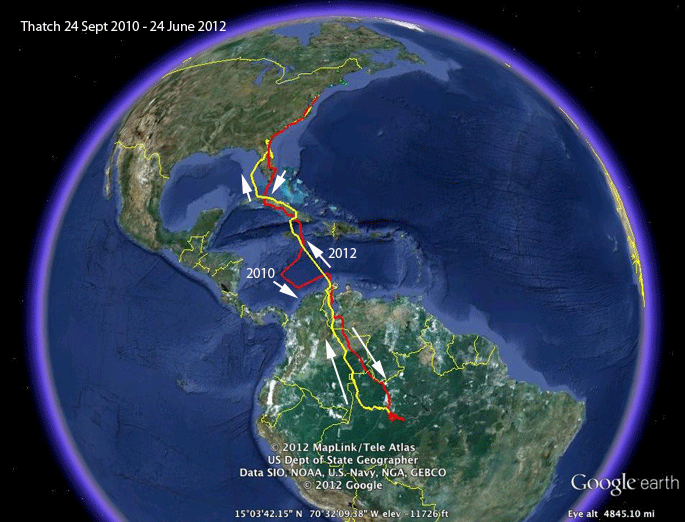 |
24 Sept 2010 - 24 June 2012. The whole round trip--660 days from the start of his fall migration to his return home in 2012. |
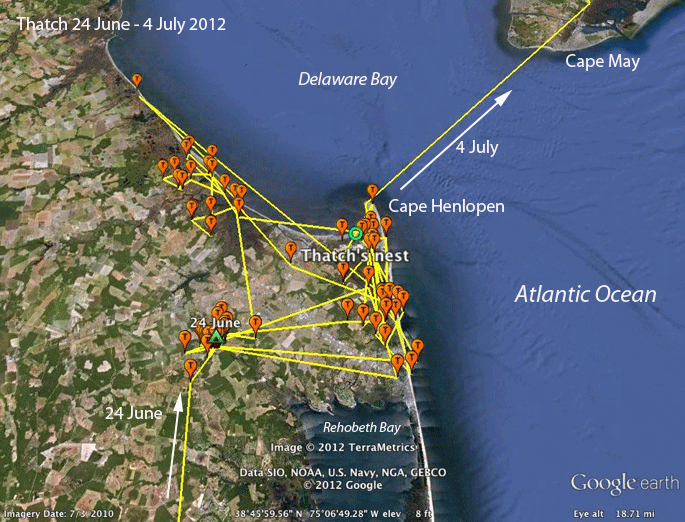 |
24 June - 4 July 2012. Thatch is back in his 'hood! He spent 11 days around his natal territory before heading out across the mouth of the Delaware Bay on July 4th. |
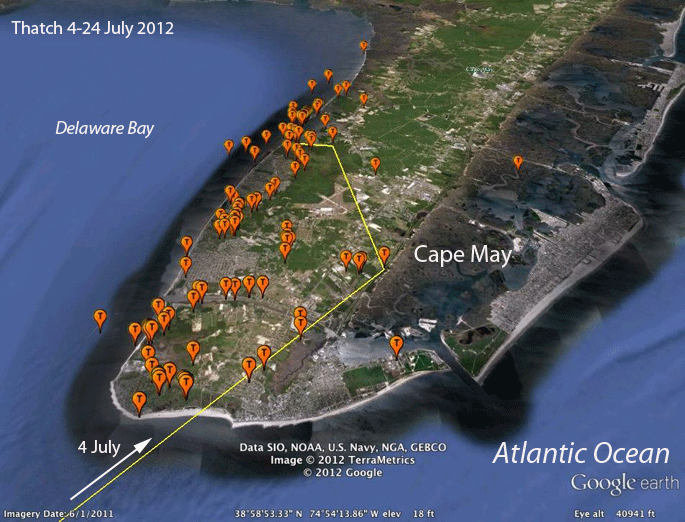 |
4-24 July 2012. Thatch is exploring Cape May, NJ. |
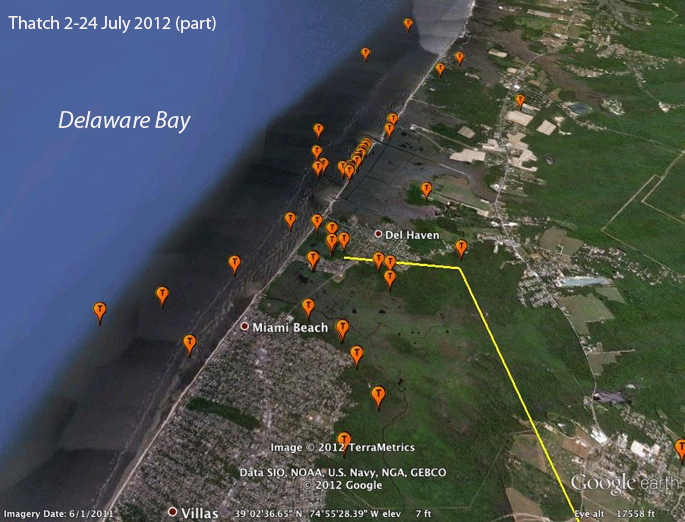 |
18-24 July 2012. Thatch has found some good fishing in the shallow waters of Delaware Bay near Del Haven, NJ, and (just to confuse us) Miami Beach. (Seriously?) |
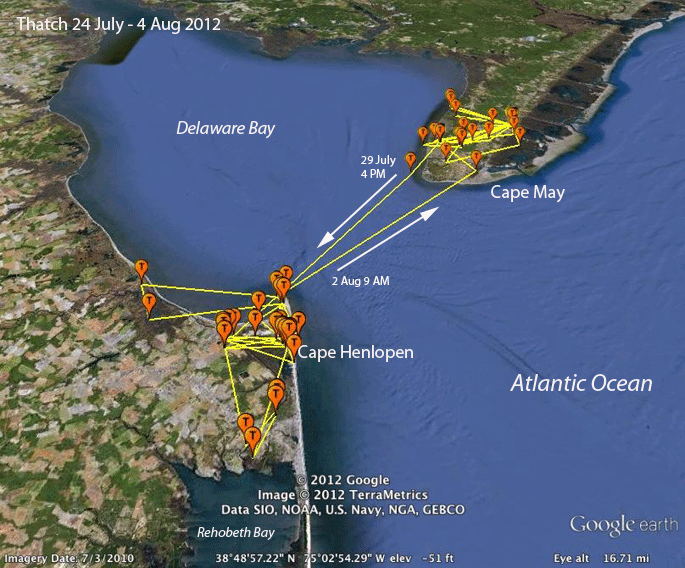 |
24 July-4 Aug 2012. Thatch made a 3-day trip back to his home turf in Delaware, but decided he likes Cape May better. For the moment. |
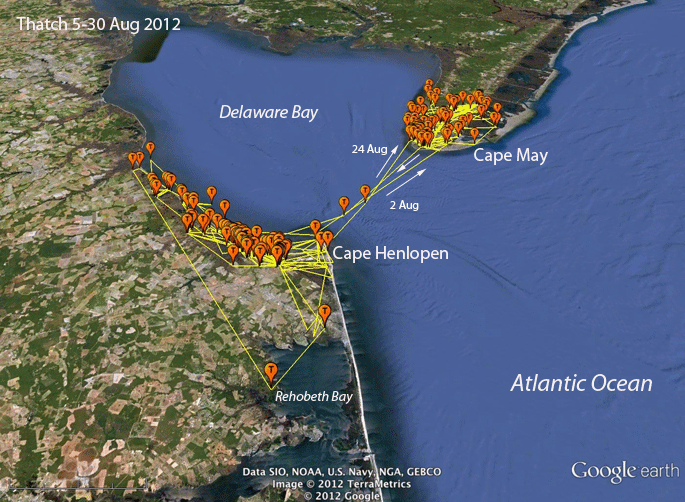 |
5-30 Aug 2012. Thatch left Cape May on Aug 12th and spent 2 weeks flying around his natal home range in Cape Henlopen, DE. On the 24th he flew back to Cape May, where he's been since. He should be heading south soon. |
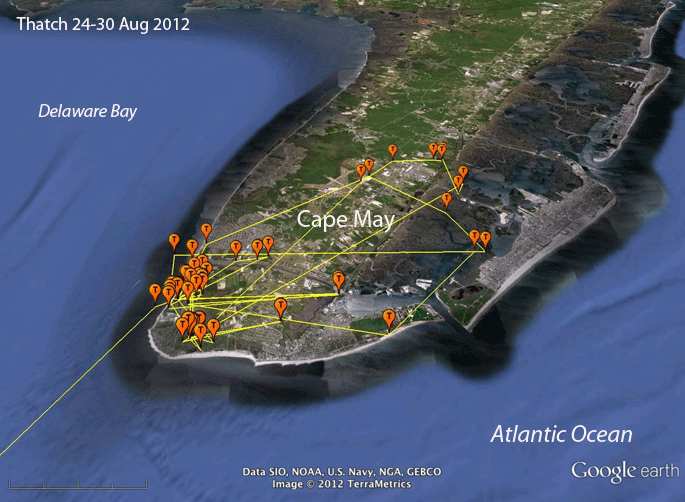 |
24-30 Aug 2012. Thatch is over on Cape May teasing the hawk watchers. |
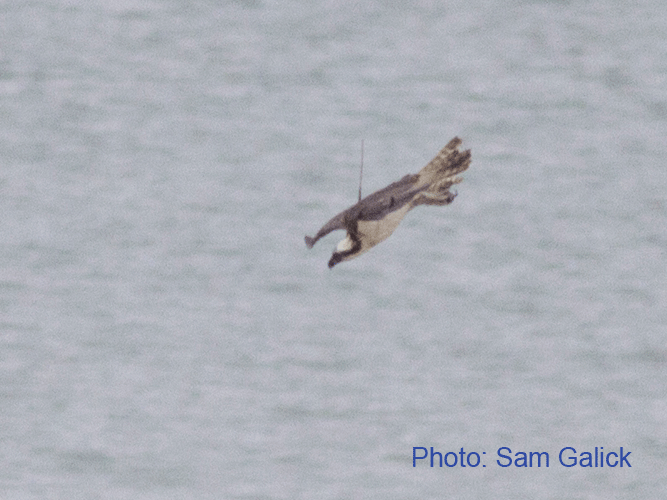 |
3 Sep 2012. Sam Galick was birding on Cape May when he took this picture of Thatch about to catch some fuel for the trip south. Sam reports that Thatch has been spotted several times by the migration counters at the Cape May Hawk Watch platform. Thatch took off for points south 12 days later, on the 15th. |
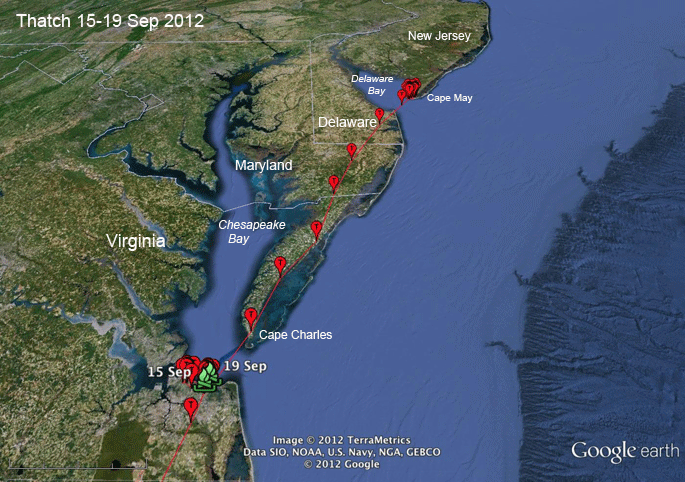 |
15-22 Sep 2012. Thatch started his migration, leaving Cape May at about 9:30 AM on the 15th--teenagers never get started early! By 2 PM he was in his 4th state for the day and between 4 and 5 PM he was flying across the mouth of Chesapeake Bay, right over the Bridge-tunnel. He settled down for four days between Norfolk and Virginia Beach. |
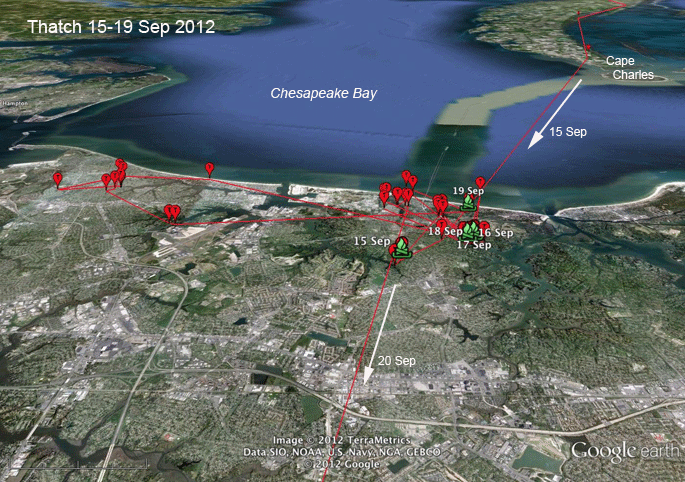 |
15-19 Sep 2012. Thatch spent 4 days here on the southern edge of Chesapeake Bay. A nasty storm was moving up the coast during these days, so that explains the hiatus in his migration. |
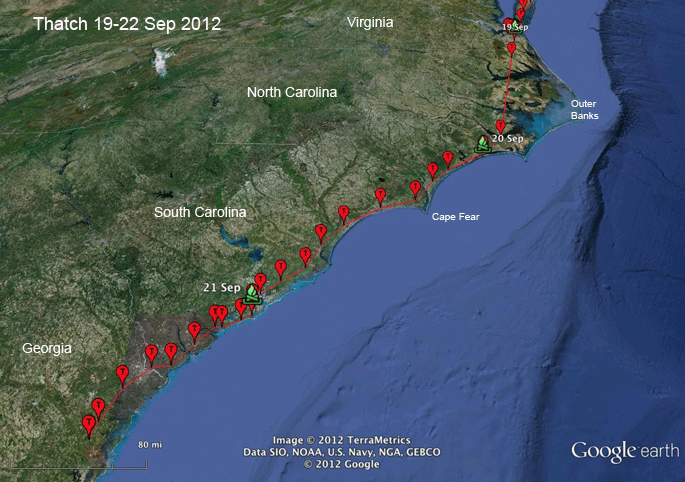 |
19-22 Sep 2012. Thatch left the Virginia Beach area sometime before 9 AM and settled down for the night of the 20th near Jacksonville, NC, about 9 hours later. He covered 222 miles (357 km) during the day, averaging probably about 22 MPH--a bit on the low side of normal cruising speed for a migrating Osprey, but only by a little. |
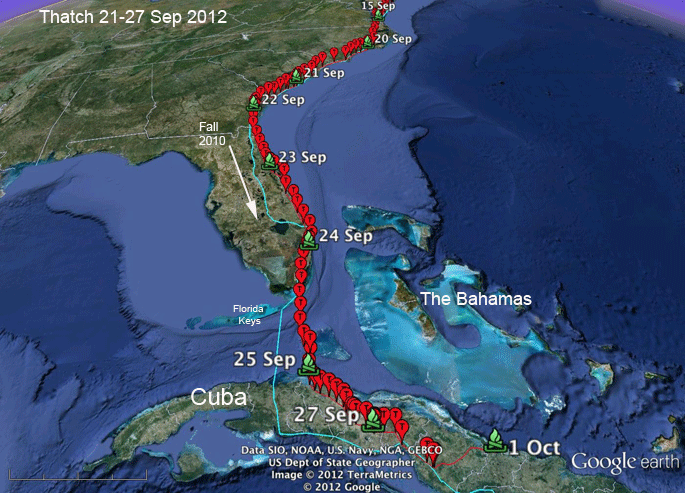 |
21-27 Sep 2012. Thatch is really hugging the coast as he heads south. He's making great time. The blue track is his route south on his first trip south back in 2010. |
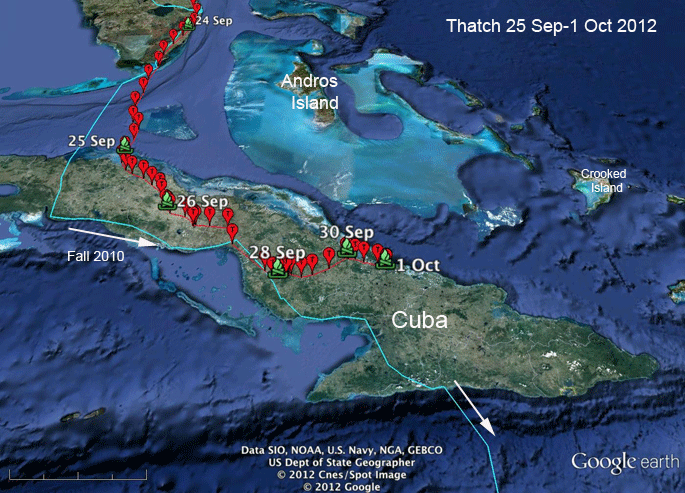 |
25 Sep-1 Oct 2012. Thatch slowed down a bit in Cuba. His moves on the 27th and 29th were short ones. So was the move on the 1st. |
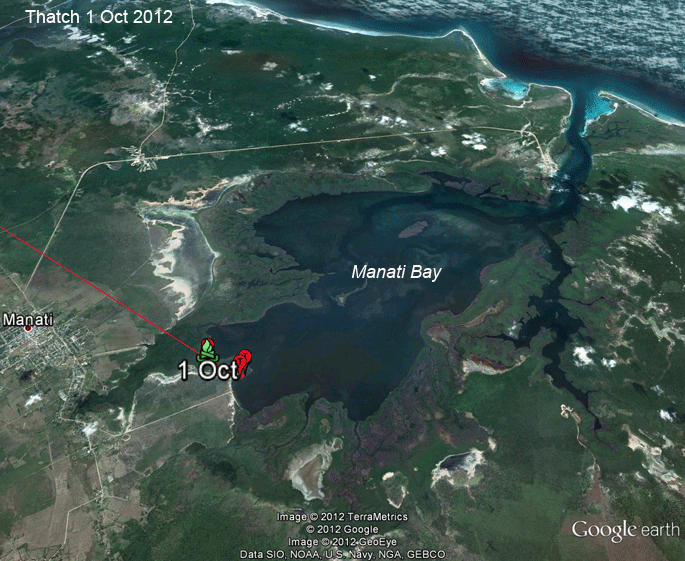 |
1 Oct 2012. Thatch is in a good place. Looks like a big shallow bay and no tempting fish farms nearby! |
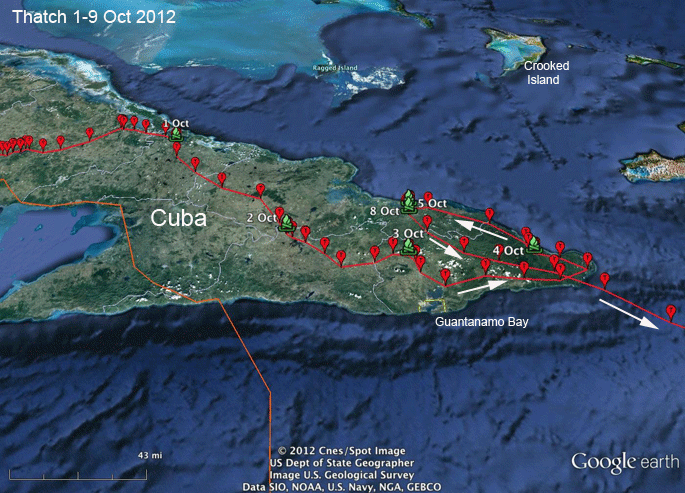 |
1-9 Oct 2012. Thatch got to the eastern tip of Cuba around 3 PM on the 3rd and decided not to make the jump over to Hispaniola. He backtracked along the north shore and settled down for three days. He then took off on the 9th shortly after 8 AM. About 4 hours later he left Cuba behind. |
.gif) |
9-11 Oct 2012. Thatch crossed the open water between Cuba and Hispaniola in just over 2 hours and settled down for the night a couple of hours later. On the 10th he moved into the D.R. and, overshooting the normal route to South America via Cabo Beata, he pushed on to the east. |
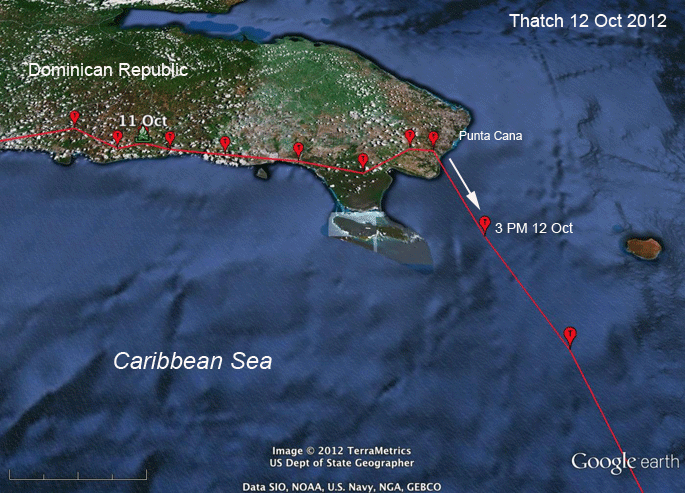 |
9-11 Oct 2012. Thatch ran out of land and headed southeast just south of Punta Cana just after 2 PM. |
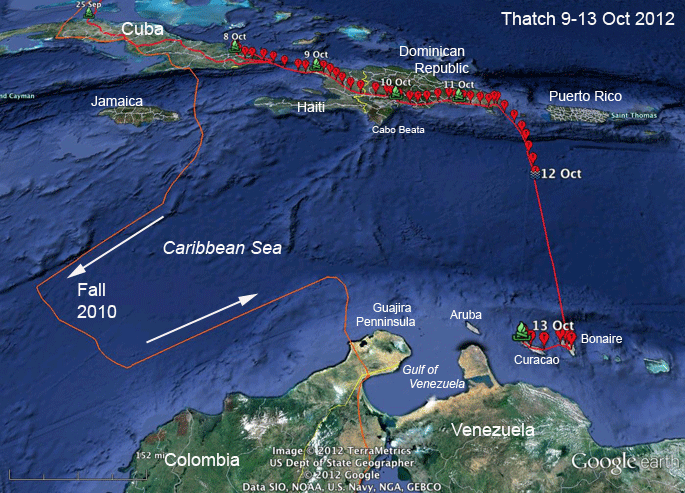 |
12-13 Oct 2012. Thatch had a much easier crossing in 2012 than he did in 2010. That year, he was blown every which way by a series of storms and rather miraculously survived an 1,100 mile journey that lasted about 57 hours. This year was a cake walk by comparison. His crossing to Bonaire was only 430 miles (695 km) and took a mere 17 hours. He is now 1,130 miles (1,820 km) from his wintering area on the Amazon River. |
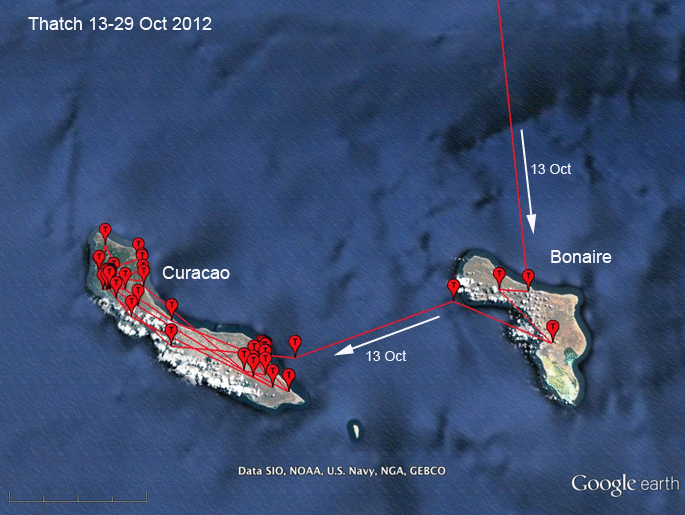 |
|
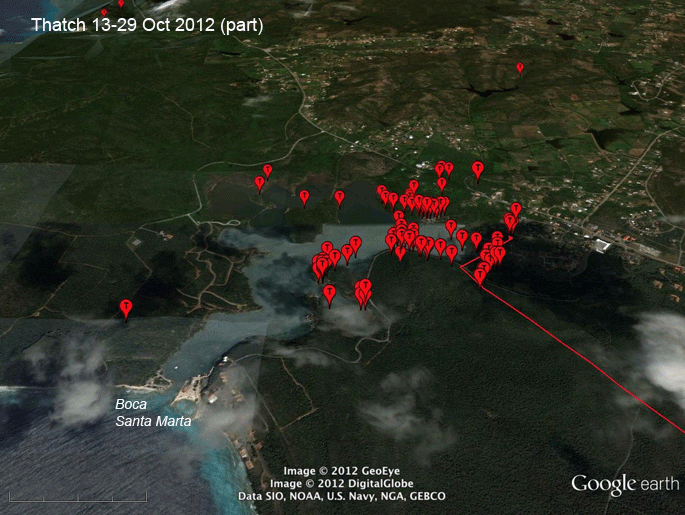 |
13-29 Oct 2012. Thatch put his migration on hold while he tried to catch all the fish in this small bay in western Curacao. Sadly, this was the last stop for Thatch. If pressed, I'd have to guess he was shot. He was migrating in good form and seemingly had no trouble crossing the Caribbean. This is not the first bird we've lost under suspicious circumstances on Curacao. Back in the fall of 2010, "Mr. Hannah," and adult male from Nantucket, spent some time in this very lagoon and then moved back down the island to a more populated area where his signals ended. |